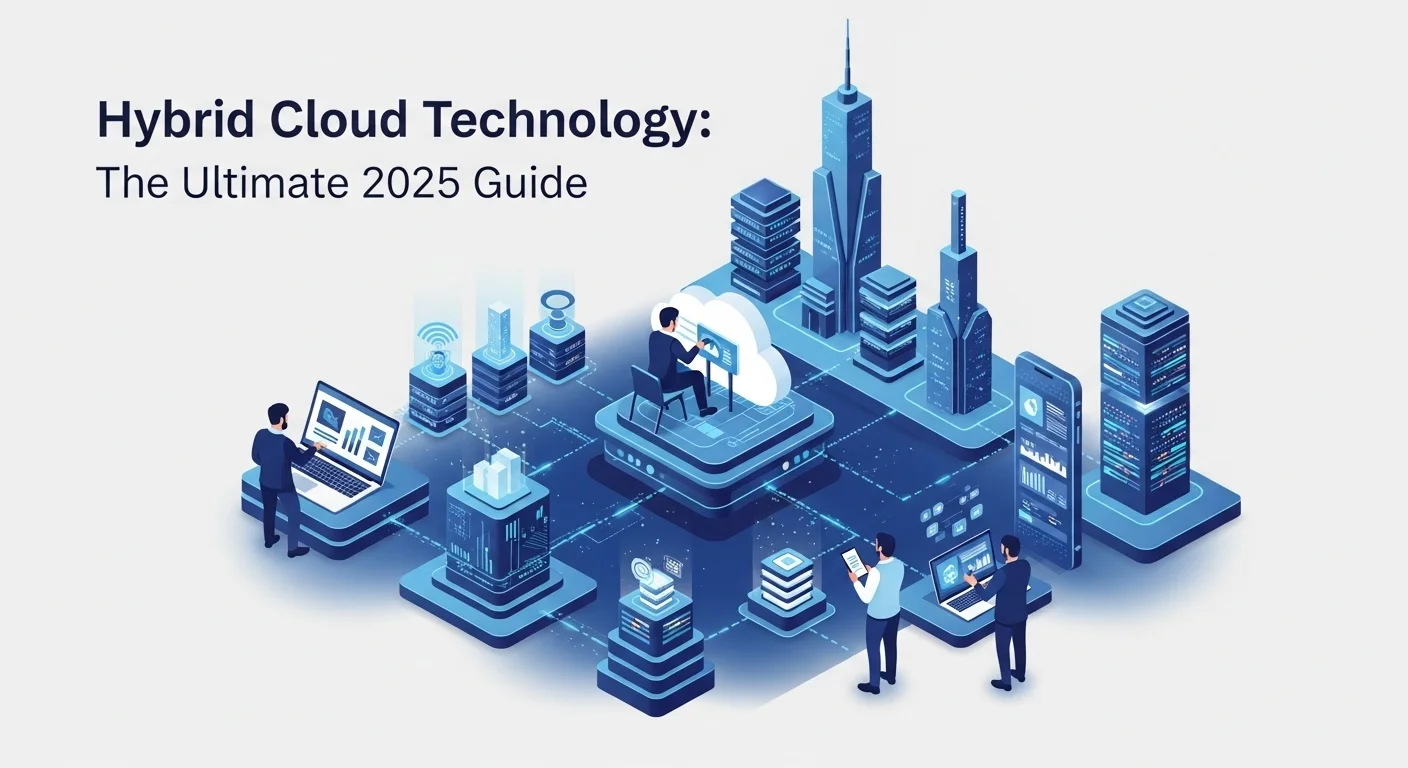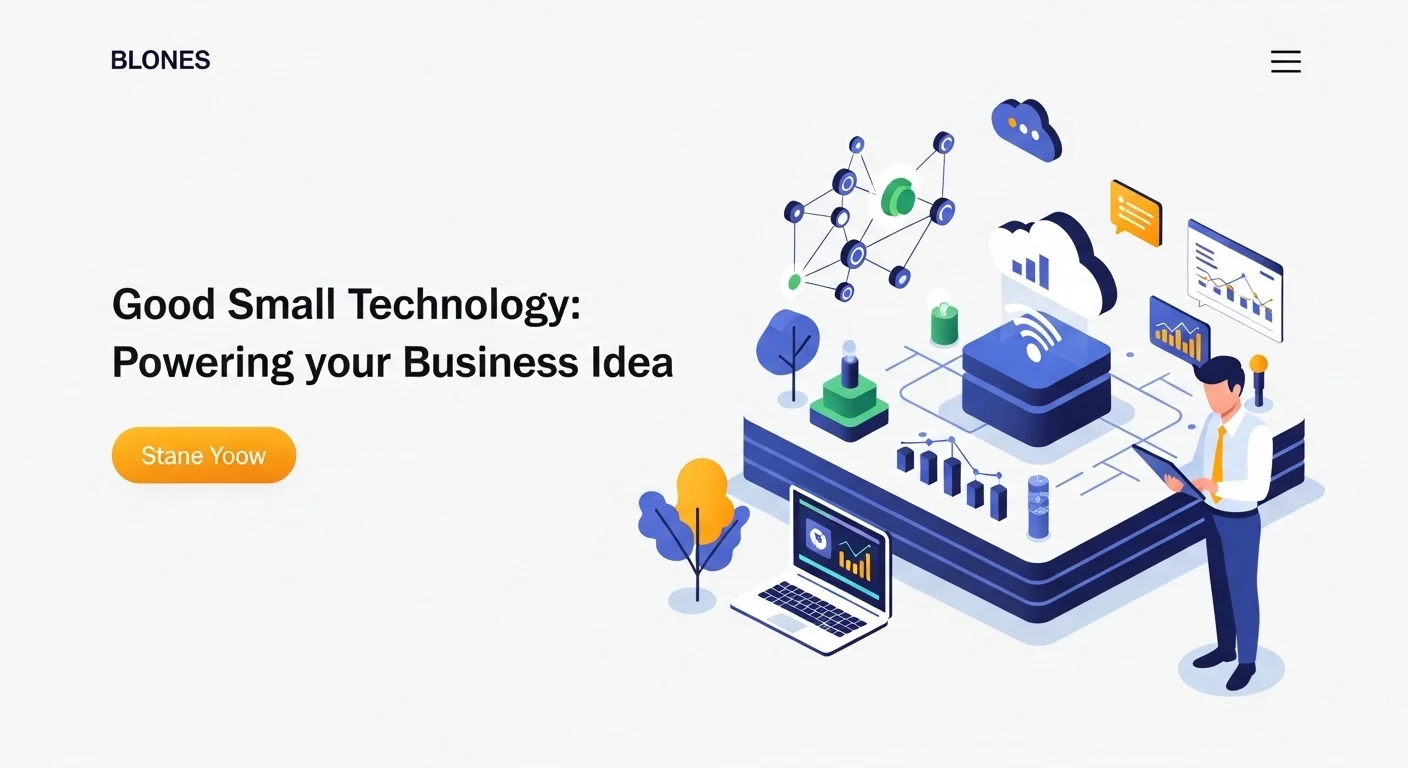Hybrid Cloud Explained: Your Practical Guide to Smarter Tech & Business Growth

Executive Summary
Feeling stuck between the security of your own servers and the power of the public cloud? You're not alone. I've spent years helping companies navigate this, and the solution is often a hybrid cloud approach that lets you have both. This guide is my way of walking you through how this flexible setup can save you money, tighten security, and give your business the agility to innovate faster. We'll look at real-world examples in finance and healthcare and explore what's coming next with AI and edge computing. This is a must-read for any forward-thinking leader looking to make a smart IT investment.
Table of Contents
Table of Contents
1. What is a Hybrid Cloud, Really?
2. Why It's a Game-Changer for Modern Business
3. The Core Benefits: More Than Just Tech
4. Hybrid Cloud in Action: Real-World Examples
What is a Hybrid Cloud, Really?
In my years as a cloud strategist, I've seen countless companies wrestle with a big decision: 'Do we keep our servers in-house or go all-in on the public cloud?' The truth is, it's rarely an either-or question anymore. Think of a hybrid cloud as the practical, best-of-both-worlds answer. Simply put, it's an IT setup that connects your own private, on-premise infrastructure with a public cloud service, like those from Amazon (AWS), Microsoft (Azure), or Google. They work together as one cohesive environment. This allows your data and applications to move between them, giving you incredible flexibility in how you run your business.
So, what does that look like? Imagine you have a private cloud—your secure, controlled home base—and you connect it to a powerful public cloud. This connection is the secret sauce. It lets you use the public cloud for massive, non-sensitive tasks while keeping your most critical data safe and sound in your private environment. You get the scalability of the public cloud and the control of a private one. This isn't just a niche trend; it's a massive shift in IT strategy. We're seeing explosive growth in hybrid adoption because businesses are realizing that a single-cloud approach just doesn't cut it in today's world.
The Technological Importance of Hybrid Cloud Computing
The real magic of a hybrid approach is that it lets you build a solution that fits your company's unique needs, not the other way around. It’s about tailoring the technology to your business goals. Let’s break down why this is such a powerful concept.
The Core Benefits: More Than Just Tech
1. Unmatched Flexibility and Speed
Flexibility is the benefit everyone talks about, and for good reason. With a hybrid model, you can scale your resources on demand. I once worked with a retail company that saw its website traffic explode every Black Friday. Instead of buying massive servers that would sit unused for 11 months of the year, they used the public cloud to handle the temporary surge. This is called 'cloud bursting.' This agility means you can react to market changes in an instant, test new ideas without a huge upfront cost, and scale up successful projects without waiting weeks for new hardware to arrive.
2. Ironclad Security and Compliance
If you're in finance or healthcare, you know that security isn't just a feature; it's the foundation of your business. A hybrid cloud lets you keep sensitive patient records or financial data on a highly secure private server that you control completely. This makes meeting strict compliance rules like HIPAA or GDPR much more straightforward. Meanwhile, your public-facing website or development work can live on the public cloud, taking advantage of its scale and cost benefits. It's about putting the right workload in the right place for the right reasons.
3. Smarter Spending and Efficiency
A hybrid setup is often a huge win for your budget. By using the public cloud's pay-as-you-go model, you avoid the huge capital expense of building an infrastructure that can handle your absolute busiest day. You only pay for the extra horsepower when you need it. This also means you can get more value out of the hardware you already own, extending its life before you need to consider a full migration. It's a financially strategic move that optimizes your total cost of ownership.
4. Improved Reliability and Peace of Mind
What happens if your main data center goes down? Business continuity is everything. Hybrid clouds offer fantastic disaster recovery options. You can easily back up your on-premise data and applications to the public cloud. If there's an issue at your primary site, you can quickly switch over to the cloud environment, which minimizes downtime and keeps the business running. In my experience, this is often cheaper and far less complex than building and maintaining a second physical disaster recovery site.
Business Applications Across Industries
The adaptability of hybrid cloud is why we're seeing it pop up everywhere:
- Financial Services: Banks use it to protect sensitive data on-premise while using the public cloud to build and test new mobile banking apps.
- Healthcare: Hospitals keep patient records (PHI) secure in private clouds but use the public cloud's power for large-scale medical research and telehealth services.
- Retail and E-commerce: Retailers manage their core inventory systems in-house but rely on the public cloud to ensure their websites don't crash during massive sales events.
- Manufacturing: Factories process real-time sensor data on-site for quality control, then send it to the public cloud for long-term analysis and predictive maintenance.
Big players like AWS, Microsoft, and Google have developed incredible services (like AWS Outposts, Azure Arc, and Google Anthos) that make managing these hybrid environments much simpler. They essentially extend the public cloud experience right into your data center, giving you a single control panel to manage everything. This shift isn't just about technology; it's a fundamental change in business strategy that helps companies become more resilient and innovative.

Complete guide to Hybrid Cloud in Technology and Business Solutions
Making the move to a hybrid cloud is a major step, but it doesn't have to be overwhelming. From my experience, success comes down to solid planning and a clear understanding of your goals. This isn't just about plugging a few things together; it's about building a single, streamlined system that works for you. Let’s walk through how to design and manage a hybrid solution that truly delivers.
Designing and Implementing Your Hybrid Cloud Architecture
A great hybrid strategy starts with a smart blueprint. Think of it as designing a house before you start building. Here are the key steps I always recommend to clients.
1. Take Stock and Plan Your Move
Before you do anything technical, you need to understand your current setup. It's a critical first step that many people try to rush.
- Analyze Your Workloads: Make a list of all your applications. Which ones handle sensitive data and need to stay on-premise? Which have fluctuating demand and would be perfect for the public cloud? Be honest about what belongs where.
- Define Your 'Why': Get crystal clear on what you want to achieve. Are you trying to cut costs, become more agile, improve your disaster recovery, or all of the above? Aligning your tech goals with your business objectives is essential.
- Map the Connections: Understand how your applications and databases talk to each other. This dependency map will be your guide for a smooth, phased migration that doesn't cause unnecessary headaches.
2. Choose the Right Partners and Tools
Picking the right cloud provider is like choosing a business partner. While AWS, Azure, and Google are the giants, they each have their strengths and unique hybrid services.
- AWS Outposts: If your team is already skilled in AWS, Outposts is a fantastic choice. It literally brings AWS hardware and services into your own data center for a truly consistent experience.
- Microsoft Azure Arc: For businesses heavily reliant on Microsoft products like Windows Server, Azure Arc is a natural fit. It lets you manage your entire infrastructure—on-premise, multi-cloud, and edge—from the familiar Azure portal.
- Google Anthos: If you're building modern, container-based applications, Anthos is a powerhouse. It's built on Kubernetes and gives you the freedom to run your apps anywhere.
Your choice will depend on your existing tech, your team's skills, and your budget. Many businesses I work with even use a multi-cloud approach, picking services from different providers to get the best of all worlds and avoid being locked into a single vendor.
3. Build a Secure and Fast Connection
The network is the glue that holds your hybrid cloud together. A slow or insecure connection will undermine the whole setup. You have two main options:
- Virtual Private Network (VPN): This creates a secure, encrypted connection over the internet. It's a good, cost-effective starting point for less critical workloads.
- Direct Connection: For your most important applications, you'll want a dedicated, private line. Services like AWS Direct Connect or Azure ExpressRoute offer a super-fast, reliable, and more secure connection that bypasses the public internet entirely.
Business Techniques for Maximizing Hybrid Cloud Value
Adopting a hybrid cloud is a business decision first and a tech decision second. To get the best return on your investment, you need to think strategically.
1. Unify Your Governance and Compliance
Managing rules and regulations across different environments can feel chaotic. The key is to create a single framework for governance.
- Automate Your Policies: Use 'Policy as Code' to automatically enforce your security and compliance rules everywhere. This reduces human error and ensures consistency.
- Centralize Your Auditing: Use tools that give you a single dashboard to monitor everything. This makes it so much easier to prove compliance with regulations like GDPR or HIPAA.
- Classify Your Data: Know what data you have and how sensitive it is. This simple act of classification ensures that critical information always stays in the most secure environment.
2. Master Your Costs with FinOps
One of the biggest draws of the cloud is cost savings, but without good management, bills can quickly get out of hand. FinOps is a practice that brings financial discipline to your cloud spending.
- See Everything in One Place: Use tools that show you costs from both your private and public clouds on one screen. You can't optimize what you can't see.
- Right-Size Your Resources: Constantly monitor your usage and turn off what you're not using. Shutting down development environments overnight is an easy win that adds up fast.
- Be Strategic with Placement: Regularly review where your workloads are running. A stable, predictable application might be cheaper to run on-premise over the long term.
3. Avoid Getting Locked In
While it's easy to go deep with one provider, you don't want to get stuck. I always advise clients to keep their options open.
- Embrace Open-Source: Building on platforms like Kubernetes makes your applications portable. You can move them between clouds much more easily if needed.
- Consider Multi-Cloud: Don't be afraid to use services from more than one public cloud provider. This gives you leverage and access to best-in-class tools for every job.
Comparisons: Hybrid Cloud vs. Other Models
It's helpful to know how a hybrid cloud differs from other terms you'll hear:
- Hybrid vs. Multi-Cloud: A hybrid cloud specifically combines a private and public cloud. Multi-cloud simply means using more than one public cloud (like AWS and Azure) and doesn't always include a private component.
- Hybrid vs. Private Cloud: A private cloud is all yours, offering great control but with high costs and limited scalability. A hybrid model adds the public cloud's power and flexibility to your private setup.
- Hybrid vs. Public Cloud: A public cloud offers incredible scale but may not meet your security or compliance needs for every workload. A hybrid approach gives you a practical middle ground.
Ultimately, a successful hybrid cloud journey is built on smart planning and business alignment. By choosing the right tools and managing your environment strategically, you can unlock a powerful model for innovation and growth.

Tips and strategies for Hybrid Cloud to improve your Technology experience
Getting your hybrid cloud up and running is just the beginning. From my experience, the companies that truly succeed are the ones that continuously optimize, secure, and future-proof their environments. It’s an ongoing process. Here are some of my go-to tips and advanced strategies to make sure your hybrid setup is a powerful engine for your business, not just a complex piece of infrastructure.
Best Practices for a Secure and Resilient Hybrid Cloud
In a hybrid world, you can't just build a wall around your network and call it secure. You have to assume threats can come from anywhere. This requires a smarter, more modern approach to security.
1. Adopt a 'Zero Trust' Mindset
The core idea of Zero Trust is simple: 'never trust, always verify.' It means you don't automatically trust any user or device, even if they're already inside your network.
- Micro-segmentation: I often describe this as putting a secure bubble around each application. By dividing your network into tiny, isolated zones, you prevent an attacker from moving freely if they do get in.
- Strict Identity Management (IAM): Use multi-factor authentication (MFA) everywhere you can. Grant people the absolute minimum access they need to do their jobs—nothing more. This 'principle of least privilege' is fundamental.
- Constant Monitoring: You need eyes on everything, all the time. Use modern security tools to watch for suspicious activity across both your on-premise and cloud environments, so you can catch threats early.
2. Encrypt Everything, Everywhere
This is non-negotiable. Your data needs to be protected whether it's sitting on a server or moving across the network.
- Data at Rest: Encrypt all data stored in your databases and cloud storage. Use key management services from your cloud provider to handle the encryption keys securely.
- Data in Transit: Ensure all data moving between your data center and the cloud is encrypted. This protects it from being intercepted as it travels over the network.
3. Automate Your Security
Trying to manage security manually in a dynamic cloud environment is a recipe for disaster. It's too complex and things change too quickly. Automation is your best friend.
- Security as Code: Build your security rules directly into your deployment scripts. This ensures that every new server or application is launched with the correct security policies from the very start.
- Automated Compliance Checks: Use tools that constantly scan your setup to make sure you're compliant with regulations like HIPAA or PCI DSS. They can alert you in real-time if something falls out of line.
Strategies for Cost and Performance Optimization
A well-run hybrid cloud should save you money and improve performance. But this doesn't happen by accident. It requires continuous attention.
1. Get a Handle on Your Cloud Bill with FinOps
FinOps is about bringing financial discipline to the cloud. It's a team effort between your tech, finance, and business departments to make smart spending decisions.
- Create a Single Cost Dashboard: You need a unified view of your spending across all environments. This is the only way to spot trends and find opportunities to save.
- Foster Accountability: Show teams how much their projects are costing the business. When people see the numbers, they naturally become more cost-conscious.
- Set Up Spending Alerts: Implement automated alerts for any sudden cost spikes. This has saved my clients from shocking bills more times than I can count.
2. Put Your Workloads in the Right Place
The flexibility of a hybrid cloud means you can move applications to the most logical and cost-effective location. This isn't a one-time decision.
- Optimize for Performance: Keep applications that need lightning-fast response times close to your users, whether that's on-premise or in a specific cloud region.
- Consider 'Data Gravity': Big datasets are heavy—they're hard and expensive to move. It's almost always better to move your applications closer to the data, not the other way around.
- Modernize for Portability: I strongly encourage teams to containerize older applications using tools like Docker and Kubernetes. This makes them incredibly portable, allowing you to move them between clouds with ease as your needs change.
3. Use the Right Tools for the Job
The market for hybrid cloud tools is fantastic. Using the right ones can make a world of difference.
- Observability Platforms: Tools like Datadog or New Relic give you deep insights into not just *what* is broken, but *why*. They are essential for troubleshooting complex hybrid systems.
- Infrastructure as Code (IaC): Tools like Terraform and Ansible are must-haves for automating how you build and manage your infrastructure. They ensure consistency and save a ton of time.
- Cloud Management Platforms (CMPs): These platforms give you a single control panel to manage resources, costs, and security across your entire hybrid and multi-cloud landscape.
Future-Proofing Your Hybrid Strategy
The tech world never stands still. A smart hybrid strategy looks ahead to what's coming next.
- AI-Driven Operations (AIOps): The future of IT management is AI. AIOps tools will predict problems before they happen and automate complex troubleshooting, making your environment more resilient.
- Integrating the Edge: Edge computing is becoming a key part of the hybrid puzzle. As IoT devices become more common, you'll need to process more data at the source. Plan for the edge to be another layer of your infrastructure.
- Focus on Sustainability: Green computing is becoming a business imperative. A hybrid strategy can help you run workloads in the most energy-efficient data centers and optimize resource usage to lower your carbon footprint.
By applying these practices, you can turn your hybrid cloud from a complex IT project into a true strategic asset for your business. For those looking for more detailed steps, Cloudian offers a great guide on building a winning hybrid cloud strategy that I often recommend.
Expert Reviews & Testimonials
Sarah Johnson, Business Owner ⭐⭐⭐⭐
As a non-tech person, this was incredibly helpful. The analogies, like comparing cloud bursting to handling Black Friday traffic, really made sense. I feel like I can finally have an intelligent conversation about this with my IT team.
Mike Chen, IT Consultant ⭐⭐⭐⭐⭐
This is a fantastic, no-fluff guide. The author clearly has real-world experience. The sections on FinOps and avoiding vendor lock-in are spot-on and provide practical advice I can use with my own clients. Great job.
Emma Davis, Cloud Engineer ⭐⭐⭐⭐⭐
Excellent article! It's comprehensive without being overly technical. I especially appreciate the focus on a 'Zero Trust' mindset and automating security. It's a great resource to share with colleagues and management to explain the 'why' behind our strategies.



